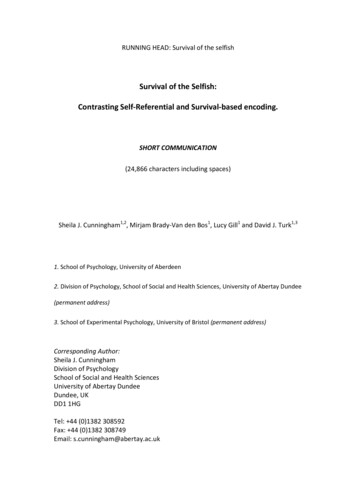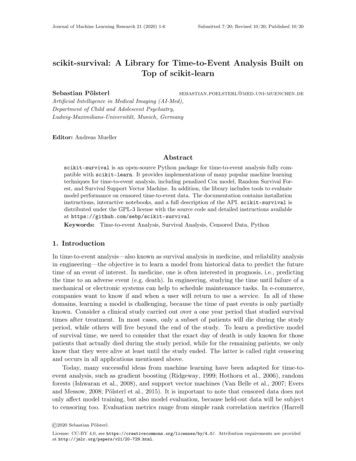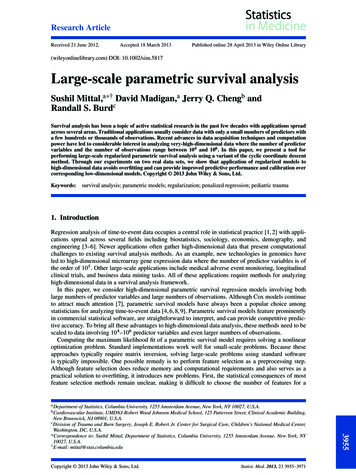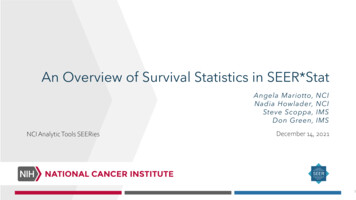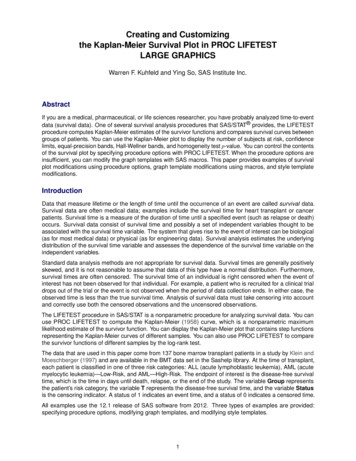
Transcription
Machine Learning forSurvival AnalysisChandan K. ReddyYan LiDept. of Computer ScienceVirginia Techhttp://www.cs.vt.edu/ reddyDept. of Computational Medicineand BioinformaticsUniv. of Michigan, Ann Arbor1
Tutorial OutlineBasic ConceptsStatistical MethodsMachine Learning MethodsRelated Topics2
Tutorial OutlineBasic ConceptsStatistical MethodsMachine Learning MethodsRelated Topics3
KDHemoglobinBlood countGlucoseHemodialysisContrast dyeCatheterizationACE CTLower healthcare costsImprove quality of lifeEvent of Interest : Rehospitalization; Disease recurrence; Cancer survivalOutcome: Likelihood of hospitalization within t days of discharge4
Mining Events in Longitudinal Data23 ve and 7 -ve3Cannot predict the time of event4Need to re-train for each time5 6Regression Problem:7Can predict the time of event8Subjects1Classification Problem:Only 3 samples (not 10)9– loss of data101 23 4 56 7 8Time9 10 11 12Ping Wang, Yan Li, Chandan, K. Reddy, “Machine Learning for SurvivalAnalysis: A Survey”. ACM Computing Surveys (under revision), 2017.- Death- Dropout/Censored- Other Events5
Problem StatementFor a given instance , represented by a triplet,,.is the feature vector;is the binary event indicator, i.e.,and0 for a censored instance;1 for an uncensored instancedenotes the observed time and is equal to the survival time for anuncensored instance and for a censored instance, i.e.,10Note for:The value ofwill be both non-negative and continuous.is latent for censored instances.Goal of survival analysis: To estimate the time to the event ofinterest for a new instance with feature predictors denoted by.6
ityCash amountIncomeScholarshipsPre-enrollmentHigh school GPAACT scoresGraduation ageEventPredictionModelEnrollmentTransfer creditsCollegeMajorSemesterSemester GPA% passed% droppedIMPACTEducated SocietyBetter FutureEvent of Interest : Student dropoutOutcome: Likelihood of a student being dropout within t daysS. Ameri, M. J. Fard, R. B. Chinnam and C. K. Reddy, "Survival Analysis based Framework for Early Prediction ofStudent Dropouts", CIKM 2016.7
CrowdfundingProjectsCreatorsDurationGoal amountCategoryPast successLocation# projectsTwitter# emporal# BackersFunding# retweetsIMPACTImprove local economySuccessful businessesEvent of Interest: Project SuccessOutcome: Likelihood of a project being successful within t daysY. Li, V. Rakesh, and C. K. Reddy, "Project Success Prediction in Crowdfunding Environments", WSDM 2016.8
Other ApplicationsReliability: Device Failure Modeling in EngineeringGoal: Estimate when a device will failFeatures: Product and manufacturer details, user reviewsDuration Modeling: Unemployment Duration in EconomicsGoal: Estimate the time people spend without a job (for getting a new job)Features: User demographics and experience, Job details and economicsClick Through Rate: Computational Advertising on the WebGoal: Estimate when a web user will click the link of the ad.Features: User and Ad information, website statisticsCustomer Lifetime Value: Targeted MarketingGoal: Estimate the frequent purchase pattern for customers.Features: Customer and store/product information.How long ?History informationEvent of interest9
Taxonomy of Survival Analysis MethodsStatistical MethodsKaplan-MeierBasic Cox-PHLasso-CoxNon-ParametricNelson-AalenPenalized CoxRidge-CoxLife-TableTime-DependentCoxEN-CoxCox RegressionCox BoostLinear dFailure TimeSurvival TreesSurvival AnalysisMethodsBayesianMethodsNeural NetworkMachineLearningSupport StructuredRegularizationNaïve BayesBayesianNetworkRandom SurvivalForestsBagging SurvivalTreesActive LearningAdvanced MachineTransferLearningEarly PredictionRelated TopicsBuckley JamesEnsembleLearningDataTransformationComplex ationCompetingRisksRecurrentEvents10
Tutorial OutlineBasic ConceptsStatistical MethodsMachine Learning MethodsRelated Topics11
Basics of Survival AnalysisMain focuses is on time to event data. Typically, survival dataare not fully observed, but rather are censored.Several important functions:DeathSurvival function, indicating the probability that the stanceinstance can survive for longer than a certain time t.PrCumulative density function, representing the probabilitythat the event of interest occurs earlier than t.Survival function1expDeath density function: Hazard function: representing the probability the “event” ofinterest occurs in the next instant, given survival to time t.lnCumulative hazard functionChandan K. Reddy and Yan Li, "A Review of Clinical Prediction Models", in Healthcare Data Analytics,Chandan K. Reddy and Charu C. Aggarwal (eds.), Chapman and Hall/CRC Press, 2015.12
Evaluation MetricsDue to the presence of the censoring in survival data,the standard evaluation metrics for regression such asroot of mean squared error andare not suitable formeasuring the performance in survival analysis.Three specialized evaluation metrics for survivalanalysis:Concordance index (C-index)Brier scoreMean absolute error13
Concordance Index (C‐Index)It is a rank order statistic for predictions against true outcomesand is defined as the ratio of the concordant pairs to the totalcomparable pairs.Given the comparable instance pair , withandare theactual observed times and S( ) and S( ) are the predictedsurvival times,The pair,is concordant if and S( ) S( ).The pair,is discordant if and S( ) S( ).Then, the concordance probabilityPrmeasures the concordance between the rankings of actualvalues and predicted values.For a binary outcome, C-index is identical to the area under theROC curve (AUC).U. Hajime, et al. "On the C‐statistics for evaluating overall adequacy of risk prediction procedures with censored survivaldata." Statistics in medicine, 2011.14
Comparable PairsThe survival times of two instances can be compared if:Both of them are uncensored;The observed event time of the uncensored instance issmaller than the censoring time of the censored instance.Without CensoringA total of 5C2 comparable pairsWith CensoringComparable only with events andwith those censored after the eventsH. Steck, B. Krishnapuram, C. Dehing-oberije, P. Lambin, and V. C. Raykar, “On ranking in survival analysis: Bounds on theconcordance index”, NIPS 2008.15
C‐indexWhen the output of the model is the prediction of survival time:1 ̂:: Whereis the predicted survival probabilities,denotes the total number of comparable pairs.When the output of the model is the hazard ratio (Cox model):1̂::Where · is the indicator function and is the estimatedparameters from the Cox based models. (The patient who hasa longer survival time should have a smaller hazard ratio).16
C‐index during a Time PeriodArea under the ROC curves (AUC) is0,11In a possible survival time , is the set of all possiblesurvival times, the time-specific AUC is defined as1,::denotes the number of comparable pairs at time .Then the C-index during a time period 0, : can be calculated as: ·C-index is a weighted average of the area under time-specific ROC17curves (Time-dependent AUC).
Brier ScoreBrier score is used to evaluate the prediction models where theoutcome to be predicted is either binary or categorical in nature.The individual contributions to the empirical Brier score arereweighted based on the censoring information:1denotes the weight for theinstance.The weights can be estimated by considering the Kaplan-Meierestimator of the censoring distribution on the dataset./1/The weights for the instances that are censored before will be 0.The weights for the instances that are uncensored at are greater than 1.E. Graf, C. Schmoor, W. Sauerbrei, and M. Schumacher, “Assessment and comparison of prognostic classification schemesfor survival data”, Statistics in medicine, 1999.18
Mean Absolute ErrorFor survival analysis problems, the mean absolute error (MAE)can be defined as an average of the differences between thepredicted time values and the actual observation time values.1 where-- the actual observation times.-- the predicted times.Only the samples for which the event occurs are beingconsidered in this metric.Condition: MAE can only be used for the evaluation of survivalmodels which can provide the event time as the predictedtarget value.19
Summary of Statistical e efficient when nosuitable theoreticaldistributions known.SemiparametricThe knowledge of theunderlying distribution ofsurvival times is notrequired.The distribution of theoutcome is unknown;not easy to interpret.Easy to interpret, moreefficient and accuratewhen the survival timesfollow a particulardistribution.When the distributionassumption is violated, itmay be inconsistent andcan give sub-optimalresults.ParametricDifficult to interpret;yields inaccurateestimates.Specific methodsKaplan-MeierNelson-AalenLife-TableCox modelRegularized CoxCoxBoostTime-Dependent CoxTobitBuckley-JamesPenalized regressionAccelerated Failure Time20
Kaplan‐Meier AnalysisKaplan-Meier (KM) analysis is a nonparametric approachto survival outcomes. The survival function is::1where-- a set of distinct event times observed in the sample. -- number of events at -- number of censored observationsbetween and.-- number of individuals “at risk” rightbefore thedeath.E. Bradley. "Logistic regression, survival analysis, and the Kaplan-Meier curve." JASA 1988.21
Survival 1263551407941132141273611142281283741Status1: Death2: Lost to follow up3: Withdrawn Alive22
Kaplan‐Meier AnalysisKaplan-Meier Analysis1Time 370.9514120136.6152110350.8747153110340.849KM Estimator::123
Kaplan‐Meier AnalysisKM Estimator:Time Status Estimate Sdv Error Time Status Estimate Sdv Error 961810.0520.0463322026910.5360.0818214079410034124
Nelson‐Aalen EstimatorNelson-Aalen estimator is a non-parametric estimator of thecumulative hazard function (CHF) for censored data.Instead of estimating the survival probability as done in KMestimator, NA estimator directly estimates the hazard probability.The Nelson-Aalen estimator of the cumulative hazard function:-- the number of deaths at time-- the number of individuals at risk atThe cumulative hazard rate function can be used to estimate thesurvival function and its variance.expThe NA and KM estimators are asymptotically equivalent.W. Nelson. “Theory and applications of hazard plotting for censored failure data.” Technometrics, 1972.O. Aalen. “Nonparametric inference for a family of counting processes.” The Annals of Statistics, 1978.25
Clinical Life TablesClinical life tables applies to grouped survival data fromstudies in patients with specific diseases, it focuses moreon the conditional probability of dying within the interval.The survival function is:The time interval is,VS.is a set of distinct death times1Assumption: at the beginning of each interval: at the end of each interval: on average halfway through the interval:Nonparametric/2KM analysis suits small data set with a more accurate analysis,Clinical life table suit for large data set with a relatively approximate result.Cox, David R. "Regression models and life-tables", Journal of the Royal Statistical Society. Series B (Methodological), 1972.26
Clinical Life TablesClinical Life TableNOTE:The length of intervalis half year(183 days)IntervalIntervalInterval Start Time End Time1040182139.58Std. Errorof0.7970.06218336531329.515 060.0500.1410.1010Clinical Life Table:1On average halfway through/2the interval:27
Statistical e efficient when nosuitable theoreticaldistributions known.SemiparametricThe knowledge of theunderlying distribution ofsurvival times is notrequired.The distribution of theoutcome is unknown;not easy to interpret.Easy to interpret, moreefficient and accuratewhen the survival timesfollow a particulardistribution.When the distributionassumption is violated, itmay be inconsistent andcan give sub-optimalresults.ParametricDifficult to interpret;yields inaccurateestimates.Specific methodsKaplan-MeierNelson-AalenLife-TableCox modelRegularized CoxCoxBoostTime-Dependent CoxTobitBuckley-JamesPenalized regressionAccelerated Failure Time28
Taxonomy of Survival Analysis MethodsStatistical MethodsKaplan-MeierBasic Cox-PHLasso-CoxNon-ParametricNelson-AalenPenalized CoxRidge-CoxLife-TableTime-DependentCoxEN-CoxCox RegressionCox BoostLinear dFailure TimeSurvival TreesSurvival AnalysisMethodsBayesianMethodsNeural NetworkMachineLearningSupport StructuredRegularizationNaïve BayesBayesianNetworkRandom SurvivalForestsBagging SurvivalTreesActive LearningAdvanced MachineTransferLearningEarly PredictionRelated TopicsBuckley JamesEnsembleLearningDataTransformationComplex ationCompetingRisksRecurrentEvents29
Cox Proportional Hazards ModelThe Cox proportional hazards model is the most commonlyused model in survival analysis.Hazard Function, sometimes called an instantaneousfailure rate, shows the event rate at time conditional onsurvival until time or later.,expwhere ,, , log,A linear model for the logof the hazard ratio.is the covariate vector.is the baseline hazard function, which can be an arbitrarynon-negative function of time.The Cox model is a semi-parametric algorithm since the baselinehazard function is unspecified.D. R. Cox, “Regression models and life tables”. Journal of the Royal Statistical Society, 1972.30
Cox Proportional Hazards ModelThe Proportional Hazards assumption means that the hazard ratio of twoinstancesandis constant over time (independent of time).,,expexpexpThe survival function in Cox model can be computed as follows:expexpis the cumulative baseline hazard function;exprepresents the baseline survival function.The Breslow’s estimator is the most widely used method to estimatewhich is given by: ifis an event time, otherwiserepresents the set of subjects who are at risk at time .,0.31
Optimization of Cox modelNot possible to fit the model using the standard likelihood functionReason: the baseline hazard function is not specified.Cox model uses partial likelihood function:Advantage: depends only on the parameter of interest and is free ofthe nuisance parameters (baseline hazard).Conditional on the fact that the event occurs at , the individualprobability corresponding to covariate can be formulated as:, ,-- the total number of events of interest that occurred duringthe observation period for instances. -- the distinct ordered time to event of interest.-- the covariate vector for the subject who has the event at-- the set of risk subjects at.32
Partial Likelihood FunctionThe partial likelihood function of the Cox model will be:exp expIf1, theterm in the product is the conditional probability;if0, the corresponding term is 1, which means that the term will nothave any effect on the final product.The coefficient vector is estimated by minimizing the negativelog-partial likelihood:exp The maximum partial likelihood estimator (MPLE) can be usedalong with the numerical Newton-Raphson method to iterativelyfind an estimator which minimizes.D. R. Cox, Regression models and life tables, Journal of the Royal Statistical Society, 1972.33
Regularized Cox ModelsRegularized Cox regression methods: is a sparsity inducing norm andMethodis the regularization parameter.Penalty Term FormulationPromotes SparsityLASSORidgeHandles CorrelationElastic Net (EN)Adaptive LASSO (AL) Adaptive Elastic Net(AEN)OSCAR Sparsity Correlation1 Adaptive Variants areslightly more effective1 Sparsity FeatureCorrelation Graph34
Lasso‐Cox and Ridge‐CoxLasso performs feature selection and estimates the regressioncoefficients simultaneously using a ℓ -norm regularizer .Lasso-Cox model incorporates the ℓ -norm into the log-partiallikelihood and inherits the properties of Lasso.Extensions of Lasso-Cox method:Adaptive Lasso-Cox - adaptively weighted ℓ -penalties on regressioncoefficients.Fused Lasso-Cox - coefficients and their successive differences arepenalized.Graphical Lasso-Cox - ℓ -penalty on the inverse covariance matrix isapplied to estimate the sparse graphs .Ridge-Cox is Cox regression model regularized by a ℓ -normIncorporates a ℓ -norm regularizer to select the correlated features.Shrink their values towards each other.N. Simon et al., “Regularization paths for Coxs proportional hazards model via coordinate descent”, JSS 2011.35
EN‐Cox and OSCAR‐CoxEN-Cox method uses the Elastic Net penalty term (combining the ℓand squared ℓ penalties) into the log-partial likelihood function.Performs feature selection and handles correlation between the features.Kernel Elastic Net Cox (KEN-Cox) method builds a kernel similaritymatrix for the feature space to incorporate the pairwise featuresimilarity into the Cox model.OSCAR-Cox uses Octagonal Shrinkage and Clustering Algorithm forRegression regularizer within the Cox framework.β is the sparse symmetric edge set matrix from a graph constructed byfeatures.Performs the variable selection for highly correlated features in regression.Obtain equal coefficients for the features which relate to the outcome insimilar ways.B. Vinzamuri and C. K. Reddy, "Cox Regression with Correlation based Regularization for Electronic Health Records", ICDM 2013.36
CoxBoostCoxBoost method can be applied to fit the sparse survivalmodels on the high-dimensional data by considers somemandatory covariates explicitly in the model.CoxBoost VS. Regular gradient boosting approach (RGBA)Similar goal: estimate the coefficients in Cox model.Differences:RGBA: updates in component-wise boosting or fitsthe gradient by using all covariates in each step.CoxBoost: considers a flexible set of candidatevariables for updating in each boosting step.H. Binder and M. Schumacher, “Allowing for mandatory covariates in boosting estimation of sparse high-dimensional survivalmodels”, BMC bioinformatics, 2008.37
CoxBoostHow to update in each iteration of CoxBoost?being the actualestimate of the overall parameter vector after steppredefined candidate sets of1 of the algorithm and, ,Assume thatfeatures in stepwith 1, ,1, ,,.Update all parametersin each setsimultaneously (MLE)Determine Best which improves theoverall fitting most UpdateSpecial case:Component-wise CoxBoost:1 , ,in each step .38
TD‐Cox ModelCox regression model is also effectively adapted to timedependent Cox model to handle time-dependent covariates.Given a survival analysis problem which involves both timedependent and time-independent features, the variables attime can be denoted as: , , , , ,Time-dependent , , Time-independentThe TD-Cox model can be formulated as:,expTime-dependent··Time-independent39
TD‐Cox ModelFor the two sets of predictors at time :,, ,,,, ,,, , ,, , ,The hazard ratio for TD-Cox model can be computed asfollows:,,Since the first component in the exponent is time-dependent, we canconsider the hazard ratio in the TD-Cox model as a function of time .This means that it does not satisfy the PH assumption mentioned inthe standard Cox model.40
Counting Process ExampleIDGender(0/1)Weight(lb)Smoke(0/1)Start Time(days)Stop Time(days)Status1 (F)125002010 1130002001125120300112013080141
Taxonomy of Survival Analysis MethodsStatistical MethodsKaplan-MeierBasic Cox-PHLasso-CoxNon-ParametricNelson-AalenPenalized CoxRidge-CoxLife-TableTime-DependentCoxEN-CoxCox RegressionCox BoostLinear dFailure TimeSurvival TreesSurvival AnalysisMethodsBayesianMethodsNeural NetworkMachineLearningSupport StructuredRegularizationNaïve BayesBayesianNetworkRandom SurvivalForestsBagging SurvivalTreesActive LearningAdvanced MachineTransferLearningEarly PredictionRelated TopicsBuckley JamesEnsembleLearningDataTransformationComplex ationCompetingRisksRecurrentEvents42
Statistical e efficient when nosuitable theoreticaldistributions known.SemiparametricThe knowledge of theunderlying distribution ofsurvival times is notrequired.The distribution of theoutcome is unknown;not easy to interpret.Easy to interpret, moreefficient and accuratewhen the survival timesfollow a particulardistribution.When the distributionassumption is violated, itmay be inconsistent andcan give sub-optimalresults.ParametricDifficult to interpret;yields inaccurateestimates.Specific methodsKaplan-MeierNelson-AalenLife-TableCox modelRegularized CoxCoxBoostTime-Dependent CoxTobitBuckley-JamesPenalized regressionAccelerated Failure Time43
Parametric Censored Regressionf(t)0.80.60.4S(t)0.20yiyi21Event density function— ,,: rate of events per unit time: The joint probability of uncensored instances.Survival functionnot happen up to time— 3Pr: the probability that the event did: The joint probability of censored instances. Likelihood function,,44
Parametric Censored RegressionGeneralized Linear Model Wherelog/1Negative log-likelihoodm,2loglogUncensoredInstanceslog 1censoredInstances45
OptimizationUse second order second-order Taylor expansion to formulate thelog-likelihood as a reweighted least squareswhere,. The first-order derivative, second-order derivative, and other components in optimization share thesame formulation with respect to · , · ,· , and F · .In addition, we can add some regularization term to encode someprior assumption.Y. Li, K. S. Xu, C. K. Reddy, “Regularized Parametric Regression for High-dimensional Survival Analysis“, 2016. SDM46
Pros and ConsAdvantages:Easy to interpret.Rather than Cox model, it can directly predict thesurvival(event) time.More efficient and accurate when the time to event ofinterest is follow a particular distribution.Disadvantages:The model performance strongly relies on the choosing ofdistribution, and in practice it is very difficult to choose asuitable distribution for a given problem.Li, Yan, Vineeth Rakesh, and Chandan K. Reddy. "Project success prediction in crowdfunding environments."Proceedings of the Ninth ACM International Conference on Web Search and Data Mining. ACM, 2016.47
Commonly Used 2expΦlogexp1Φ22log48
Tobit ModelTobit model is one of the earliest attempts to extend linear regressionwith the Gaussian distribution for data analysis with censoredobservations. In Tobit model, a latent variablelinearly depend on as:y where,is introduced and it is assumed to 0,is a normally distributed error term.For theinstance, the observable variable will be if 0,otherwise it will be 0. This means that if the latent variable is abovezero, the observed variable equals to the latent variable and zerootherwise.The parameters in the model can be estimated with maximumlikelihood estimation (MLE) method.J. Tobin, Estimation of relationships for limited dependent variables. Econometrica: Journal of the Econometric Society, 1958.49
Buckley‐James Regression MethodThe Buckley-James (BJ) regression is a AFT model.log10The estimated target valuelog loglog loglogThe key point is to calculatelog loglog·1log10, log,log,:loglogRather than a selected closed formed theoretical distribution, the Kaplan-Meier(KM) estimation method are used to approximate the F(·).J. Buckley and I. James, Linear regression with censored data. Biometrika, 1979.50
Buckley‐James Regression MethodThe Least squares is used as the empirical loss function1min2Where log log log1·1logThe Elastic-Net regularizer also has been used to penalize the BJregression (EN-BJ) to handle the high-dimensional survival data.1min2log 11222To estimate of of BJ and EN-BJ models, we just need to calculatelog based on the of pervious iteration and then minimize the lestsquare or penalized lest square via standard algorithms.Wang, Sijian, et al. “Doubly Penalized Buckley–James Method for Survival Data with High‐Dimensional Covariates.” Biometrics, 200851
Regularized Weighted Linear Regression Induce more penalize to case 1 and less penalize to case 2Y. Li, B. Vinzamuri, and C. K. Reddy, “Regularized Weighted Linear Regression for High-dimensional Censored Data“, SDM 2016.52
Weighted Residual Sum‐of‐SquaresMore weight to the censored instances whose estimatedsurvival time is lesser than censored timeLess weight to the censored instances whose estimatedsurvival time is greater than censored time.Weighted residual sum-of-squares12where weight1 0is defined as follows:100A demonstration of linearregression model for dataset withright censored observations.53
Self‐Training FrameworkSelf-training: training the model by using its own predictionTraininga basemodelUpdatetrainingsetStop when thetraining dataset won’tchangeApproximatethe survivaltime ofcensoredinstancesEstimatesurvivaltimeIf the estimated survivaltime is larger than censoredtime54
Bayesian Survival AnalysisPenalized regression encode assumption via regularization term,while Bayesian approach encode assumption via prior distribution.Bayesian Paradigm Based on observed data , one can build a likelihood function(likelihood estimator)Supposeis random and has a prior distribution denote byInference concerning.is based on the posterior distributionusually does not have an analytic closed form, requires methodslike MCMC to sample from and methods to estimate.Posterior predictive distribution of a future observation vectorwhere given Ddenotes the sampling density function ofIbrahim, Joseph G., Ming‐Hui Chen, and Debajyoti Sinha. Bayesian survival analysis. John Wiley & Sons, 2005.55
Bayesian Survival AnalysisUnder the Bayesian framework the lasso estimate can be viewed as aBayesian posterior mode estimate under independent Laplace priors forthe regression parameters.Lee, Kyu Ha, Sounak Chakraborty, and Jianguo Sun. "Bayesian variable selection insemiparametric proportional hazards model for high dimensional survival data." TheInternational Journal of Biostatistics 7.1 (2011): 1-32.Similarly based on the mixture representation of Laplace distribution, theFused lasso prior and group lasso prior can be also encode based on asimilar scheme.Lee, Kyu Ha, Sounak Chakraborty, and Jianguo Sun. "Survival prediction and variableselection with simultaneous shrinkage and grouping priors." Statistical Analysis and DataMining: The ASA Data Science Journal 8.2 (2015): 114-127.A similar approach can also be applied in the parametric AFT model.Komarek, Arnost. Accelerated failure time models for multivariate interval-censored data withflexible distributional assumptions. Diss. PhD thesis, PhD thesis, Katholieke UniversiteitLeuven, Faculteit Wetenschappen, 2006.56
Deep Survival AnalysisDeep Survival Analysis is a hierarchical generative approach tosurvival analysis in the context of the EHRDeep survival analysis models covariates and survival time in aBayesian framework.It can easily handle both missing covariates and model survival time.Deep exponential families (DEF) are a class of multi-layer probabilitymodels built from exponential families. Therefore, they are capableto model the complex relationship and latent structure to build a jointmodel for both the covariates and the survival times.is the output of DEF network, which can be used to generate theobserved covariates and the time to failure.R. Ranganath, A. Perotte, N. Elhadad, and D. Blei. "Deep survival analysis." Machine Learning for Healthcare, 2016.57
Deep Survival Analysisis the feature vector, which is supposed can be generated from a priordistribution.The Weibull distribution is used to model the survival time.a and b are drawn from normal distribution, they are parameter related tosurvival time.Given a feature vector x, the model makes predictions via the posteriorpredictive distribution:58
Tutorial OutlineBasic ConceptsStatistical MethodsMachine Learning MethodsRelated Topics59
Machine Learning MethodsBasic ML ModelsSurvival TreesBagging Survival TreesRandom Survival ForestSupport Vector RegressionDeep LearningRank based MethodsAdvanced ML ModelsActive LearningMulti-task LearningTransfer Learning60
Survival TreeSurvival trees is similar to decision tree which is built by recursivesplitting of tree nodes. A node of a survival tree is considered“pure” if all th
6 Goal of survival analysis: To estimate the time to the event of interest 6 Ýfor a new instance with feature predictors denoted by : Ý. Problem Statement For a given instance E, represented by a triplet : : Ü, Ü, Ü ;. : Üis the feature vector; Ü Üis the binary event indicator, i.e., Ü 1 for
![[ST] Survival Analysis - Stata](/img/33/st.jpg)
